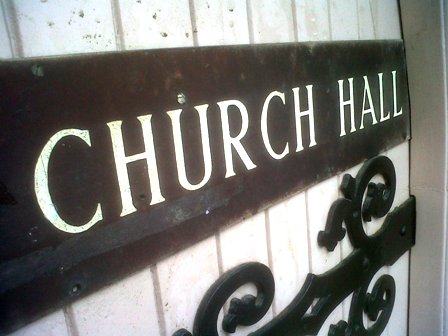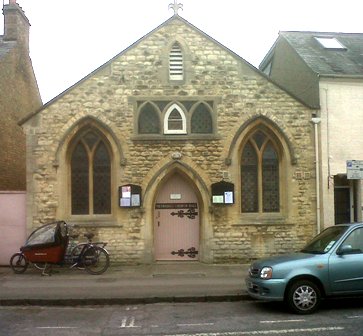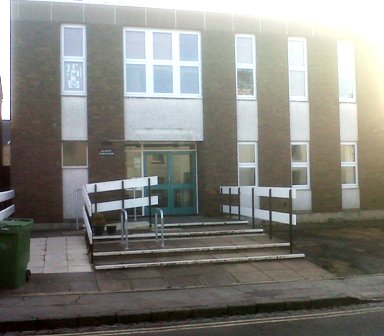
Doing what it says on the door: the nation's greatest indoor leisure resource
Builded here: a paean to the church hall
Bathed in ignorance and blinded to the obvious, Jonathan Ives has only recently discovered the joys of the UK’s greatest indoor leisure resource. Let’s hear it for the church hall

Doing what it says on the door: the nation's greatest indoor leisure resource
Having enjoyed a largely secular upbringing, my experience of churches and their associated buildings and practices has largely been limited to weddings, funerals, the occasional christening and odd visits in the pursuit of various historical or architectural interests. Consequently, beyond the regular but infrequent process of casting one’s vote, the world of church halls was a closed book to me. In contrast, Mrs Editor grew up in a Methodist household and spent most of her childhood recreational hours either in a church hall or travelling between them in pursuit of weak tea, excellent cake and a warm welcome. She wondered how I could have avoided them for so long.
Since the arrival of The Leisure Review’s blonde-haired intern (generally referred to as ‘the BHI’ in TLR correspondence), my eyes have been opened. A little while ago I spent a Saturday morning trailing around my local streets engaging in the Saturday morning pursuits of those with small children, in my case early-career ballet lessons, children’s birthday parties and community campaign meetings. After a little time and much tea, I realised that I had been in three different church halls in as many hours, all for very different events and all with a diverse range of highly engaging people. It slowly dawned on me that here, among the polite notices requesting visitors to replace the cups in the cupboard and make sure the kitchen door is kept closed, was the beating heart of the nation’s leisure sector.
So with the Olympic park reserved for the exclusive use of the construction industry and their dysfunctional cousins, the boys and girls of the demolition trade, and while we are forced to look for legacy where we may, let’s hear it for the church hall and its secular equivalent, the community centre.
‘Community centre’ it may be but, for all its various guises, ‘church hall’ is a phrase that seems better to capture the concept: a large room with some daylight from elevated windows, often a stage at one end; a kitchen, or at least a sink and room for a tea urn, at the other; enough storage space to keep a large number of folding tables and stackable chairs safely out of harm’s – or perhaps danger’s – way. It is warm in the winter, often thanks to the unfeasibly fiery radiators of a type no longer seen outside the classified pages of Home and Garden magazine, and cool in the summer, when doors are flung wide and windows winched open. For all the understatement of its utilitarian intent, have a look round and often you will find a surprisingly well-appointed and well-equipped facility. Many halls are bigger than you would imagine, with kitchens big enough for a significant catering exercise, cloakrooms with sufficienthooks for a small crowd, and store rooms full of interesting and useful equipment. Sneak up the stairs if you find them and you might find additional meeting rooms, another kitchen and all sorts of interesting spaces and displays mounted by the host organisation.
There are a wide variety of architectural styles, often reflecting the period in which the halls were built or the style of their attached or associated churches. This means that our communities are dotted with the squat Methodist halls, with their flat fronts and pitched roofs that bring a distant echo of the Welsh valleys to your local streetscape, as well as the grand and curlicued annexes of the Victorian churches built to broadcast the values of muscular Christianity to those that walked past and dared to keep walking. The community centre is often less remarkable, its square angles and flat roof owing much to the determined functionality of the 1970s and 80s, but inside it has a very similar feel, an atmosphere that suggests tea is imminent and a bustling woman called Jean will be along any minute to sort everything out to everyone’s satisfaction.
Inspired by this secret world of leisure that had been unknown to me for so long, I embarked on a journey of research and discovery, taking a bike round my local streets to gaze at the boards outside the various church halls and centres. Ballet lessons, parties and community group meetings I had uncovered already but here was so much more. Weight-loss classes with various brands and hues. Keep-fit classes with imaginative names and various promises. Pilates and yoga, annual general meetings and nursery groups. Singing groups for young and old, dance classes of all types and styles. Recycling fairs and planning debates. Talks and lectures, crèches and drama groups. Brownies, Guides and Scouts. Bring-and-share suppers, choirs and lunches. In half an hour of wandering, I had come across more activities than I could have imagined and listed in twice the time, and all within a few streets of my front door.
How many such halls do we have? Given that I counted half a dozen in as many minutes spent looking for them, it can only be a dizzying number. The 2005 English church census lists the churches by denomination, the top three being: Anglican, with 16,247 churches; Methodist, with 5,999; and Roman Catholic, with 3,656. Baptists, independents and Pentecostal follow on the list and all have more than 2,000 churches each. How many of these churches have an accompanying church hall? Many if not most. Some will have lost theirs or never had one; others will have two thanks to the weight of history and their changing roles. However one might calculate and speculate, there must be tens of thousands of church halls. We can then add the community centres to create an even larger, if entirely hypothetical, number. And however you might define or understand the UK’s leisure sector, this represents an amazing resource of community-owned and community-managed facilities.
So while the Olympic park continues to hide its world-class facilities behind linked fences and warning signs, the rest of the nation quietly gets on with its life of leisure and community endeavour in the halls and indoor spaces of various styles and denominations. I cannot deny that I am looking forward to being able to have a swim in the Olympic pool and riding the boards of the London velodrome but between now and a distant then I will be spending a lot more time in the nation’s greatest leisure resource, the church hall.
Jonathan Ives is the editor The Leisure Review.
The Leisure Review, May 2013
© Copyright of all material on this site is retained by The Leisure Review or the individual contributors where stated. Contact The Leisure Review for details.
![]() Download a pdf version of this article for printing
Download a pdf version of this article for printing

